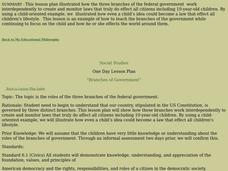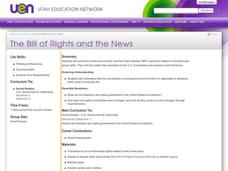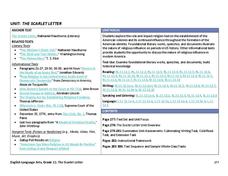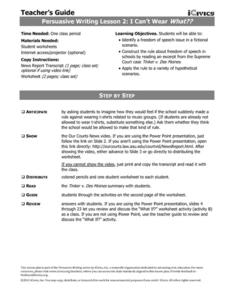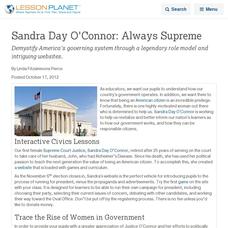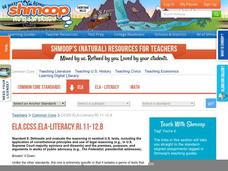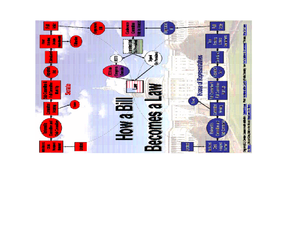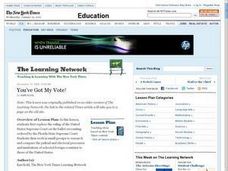Curated OER
Branches of Government
Students explore the three branches of government. In this government and U.S. history instructional activity, students listen to a story about a boy who attempts to sponsor a bill to ban cartoons. Students interview three teachers who...
Curated OER
Working for a Living: Child Labor Laws
Students research the working conditions in the late 1800's and the evolution of child labor laws. They discuss how the laws affect them today and if they are fair. They write a paper summarizing the laws and the view of the laws.
Curated OER
Michigan Judicial System Conclusion
Students identify the courts that make up Michigan's judicial system. They state the responsibilities of each court and diagram a flow chart of how a case moves to the Michigan Supreme Court. They participate in a quiz about the current...
Curated OER
The Bill of Rights and the News
Students examine current news stories and from them develop "BIG" questions related to individual and group rights. They then relate their questions to the U.S. Constitution and supreme court decisions.
Louisiana Department of Education
The Scarlet Letter
Use Nathanial Hawthorne's immortal text on the influence of religion on the early American settlements, as well as its continued impact on American culture, with a unit that focuses on The Scarlet Letter. In addition to Hawthorne's...
Teaching for Change
A Documents-Based Lesson on the Voting Rights Act
How did the Voting Rights Act affect the daily lives of American citizens? A document-based lesson developed by the Student Non-Violent Coordinating committee (SNCC) presents a case study of the impact of the Voting Rights Act of 1965 on...
Curated OER
Japanese Internment
Eleventh graders read about and discuss the Japanese Internment of World War II. In this Japanese Internment lesson, 11th graders examine the Japanese Internment. They talk about the civil rights aspect, how they would deal with being...
Curated OER
In the Light of Reverence
Students watch a documentary prior to participating in a Supreme Court simulation in order to study how religious practices are protected by the First Amendment of the Constitution. They interpret conflict from a number of perspectives...
iCivics
I Can’t Wear What?
Can schools ban t-shirts picturing musical groups or bands? Your young citizens will find out with this resource, which includes a summary of a United States Supreme Court case from the 1960s about a similar dispute over students wearing...
My Access
“Banning Books” Lesson Plan
To Kill a Mockingbird, Hunger Games, Brave New World. Welcome to Banned Books Week. As part of a study of censorship and book banning, class members investigate censorship, the purposes of censorship, and First Amendment rights,...
Curated OER
TE Activity: Pulley'ing Your Own Weight
Students experiment with common objects such as spools, string and soap to determine how pulleys make it easier to move large objects. They look at the difference between fixed and movable pulleys. They examine the many uses engineers...
Curated OER
Sandra Day O'Connor: Always Supreme
Demystify America's governing system through a legendary role model and a fabulous website.
Shmoop
ELA.CCSS.ELA-Literacy.RI.11-12.8
It is no easy feat to wade through legal and political documents. And incorporating this type of informational text into a literature class can also be a challenge. Here’s a resource that includes suggestions for how to address this...
C-SPAN
The Impact of Citizens United v. FEC
What began as an effort to show a movie by an interest group has impacted financing of federal elections. Did the Citizens United case lead to more "dark money" in politics, or did it shine a light with more speech? Using video clips...
Read Works
The United States Constitution
The US Constitution is the beginning of Americans' rights. Use a five-paragraph passage to give a brief history of the US Constitution. A great last minute addition to a lesson on Constitution Day.
Heritage Foundation
The Constitution, Federalism, and the States
The divide between federal and state government is responsible for much of tension that continues to this day, partly because of the US Constitution. The activities in the 14th lesson in a series of 20 are designed to help learners...
Curated OER
The Dred Scott Case (1857)
Students read and discuss Dred Scott v. Sandford Supreme Court case, describe in writing Constitutional principles and results of case, explain how Supreme Court decision may have helped further tensions between states, and answer...
Curated OER
How Government Works and the Rights of the People
Eighth graders identify how to be responsible citizens. In this civics lesson, 8th graders review websites of congressional members and then create questionnaires about the responsibilities of citizens.
Curated OER
Racism, Discrimination, and the Law
Seventh graders examine the various racism and discrimination faced by various ethnic groups in the United States. In groups, they research the legal system and describe the purpose of the United States Constitution. They review cases...
Curated OER
The Changing Meaning of "Due Process"
Students examine the United States Constitution and how the application for due process differs in two amendments. They research the changing definition of the term since the Civil War. They use the internet to research press coverage of...
Curated OER
Lee Yick: Fighting Racism
Students study the 14th Amendment, then review and analyze a Supreme Court brief. There was much racism exhibited toward the Chinese immigrants by the European Americans; this came in the form of institutional racism and mob violence....
Curated OER
THE JUDICIAL BRANCH
High schoolers create a series of drawings to show the process of how the Supreme Court does its work. The drawings may be in strip cartoon form or a series of separate illustrations.
Curated OER
You've Got My Vote!
Students explore the ruling of the US Supreme Court on the ballot recounting ordered by the Florida State Supreme Court. They work in small groups to research and compare the judicial and electoral processes.
Teaching Tolerance
Journalism for Justice
Roll the presses! Or at least have your class members participate in the time-honored tradition of the student press by creating their own newspapers or journalist pieces on a social problem. After conducting research and collaborating...


